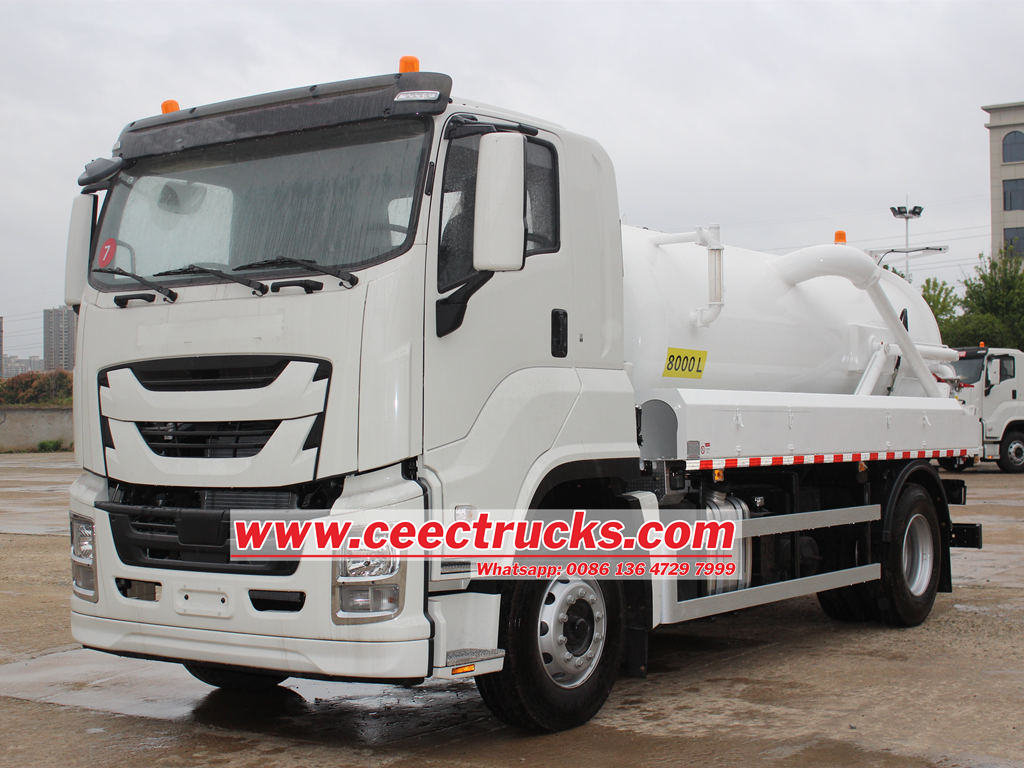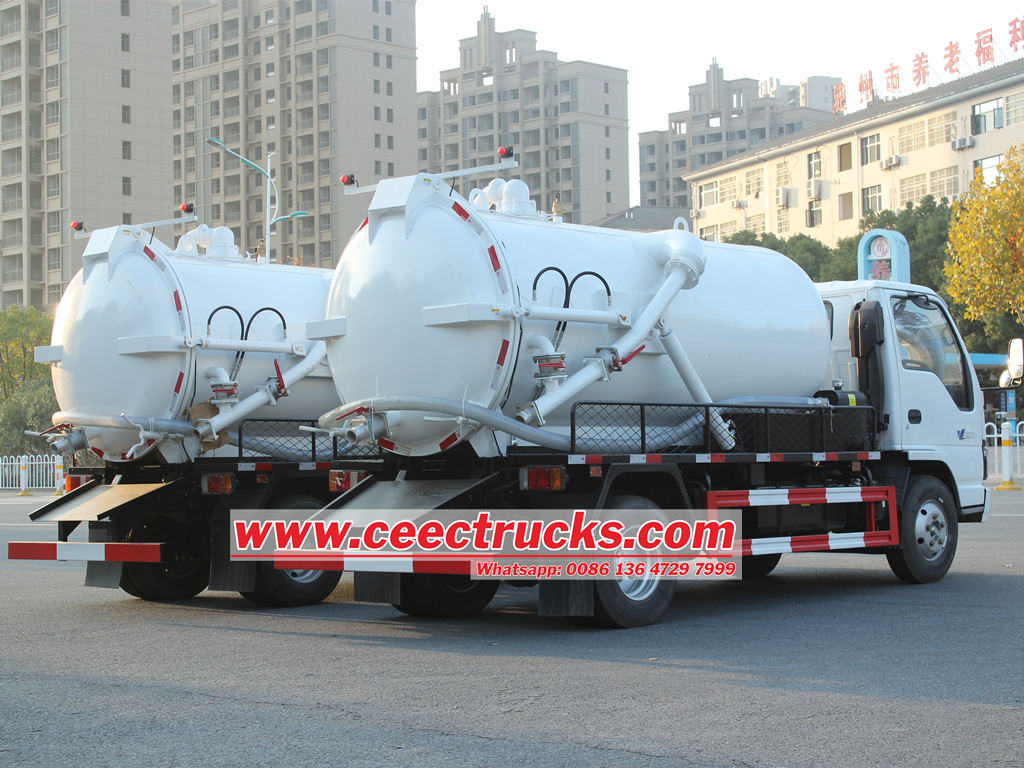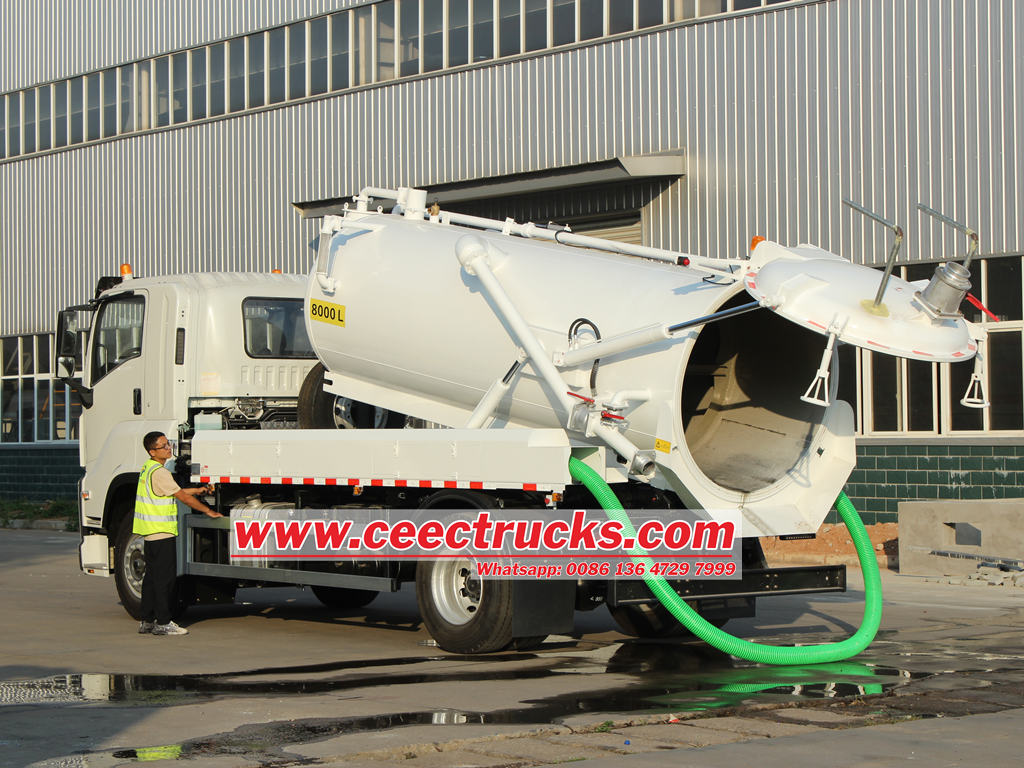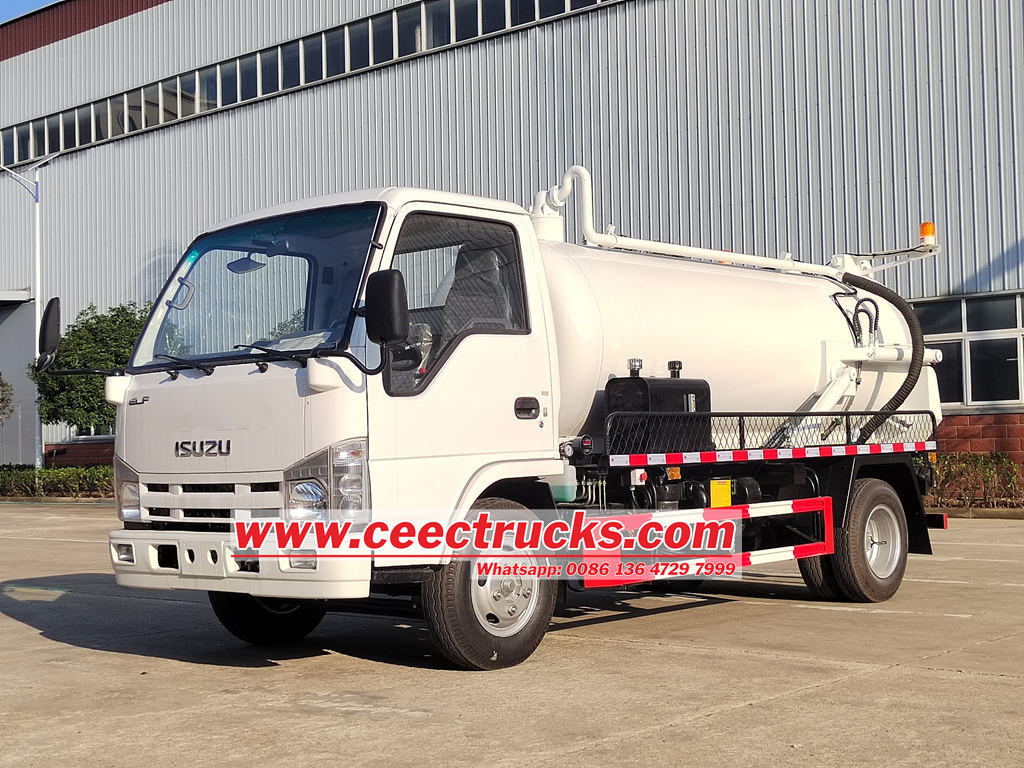
The ISUZU vacuum pump truck, with its efficient and reliable operational performance, has been widely used in sanitation, municipal administration, and other fields. The vacuum pump, serving as the "heart" of the ISUZU vacuum tank truck, directly impacts the overall operational efficiency of the vehicle. Therefore, understanding and mastering common faults and troubleshooting methods for the vacuum pump are of great significance in improving the efficiency of ISUZU septic vacuum trucks and reducing maintenance costs.

Common Faults of the Vacuum Pump in ISUZU Vacuum Sewage Suction Truck
1. Insufficient Vacuum
Fault Phenomenon:
When the vacuum pump is operating, the vacuum level indicated on the vacuum gauge is lower than the normal standard, resulting in reduced sewage suction efficiency and even inability to complete the task.
Possible Causes:
• Aging or damage to seals: Seals such as O-rings and oil seals in the vacuum pump may age, wear, or damage over time, allowing air to leak into the pump and reducing the vacuum level.
• Contaminated or insufficient pump oil: The vacuum pump oil gradually deteriorates during use, such as becoming dirty, emulsified, or mixed with incompatible oils, affecting the pump's pumping performance and sealing properties. Additionally, low oil levels can also lead to insufficient vacuum.
• System leaks: Leaks in the vacuum system's piping, valves, anti-overflow valves, four-way valves, and other components can allow gas to enter the system, reducing the vacuum level.
• Internal wear of the pump body: After long-term use, components such as the impeller and rotating vanes in the vacuum pump may wear, leading to decreased pumping efficiency.
Troubleshooting Methods:
• Inspect seals: First, check if the seals of the vacuum pump are aged, worn, or damaged, and replace them promptly if found.
• Check pump oil: Inspect the oil level and quality of the pump oil to ensure it is within the specified range and clean, free of emulsification, and impurities. If the oil quality is poor, replace the pump oil in a timely manner.
• Leak detection: Use soapy water or other leak detection tools to check for leaks in the vacuum system's piping, valves, and other components, and repair or replace them promptly if found.
• Inspect the interior of the pump body: If internal wear of the pump body is suspected, disassemble the vacuum pump for inspection. If severe wear is found on components such as the impeller and rotating vanes, replace them promptly.

2. Excessive Noise
Fault Phenomenon:
The vacuum pump emits abnormal noise during operation, such as sharp friction sounds, knocking sounds, or low rumbling sounds.
Possible Causes:
• Bearing wear: The operation of the vacuum pump relies on bearings, and wear or damage to the bearings can cause noise during operation.
• Imbalance of the impeller: The impeller may be unbalanced during manufacturing or installation, leading to vibration and noise during operation.
• Loose coupling: A loose coupling between the vacuum pump and the motor can also cause noise during operation.
• Foreign objects in the pump cavity: Foreign objects such as stones or wood blocks entering the pump cavity can produce impact sounds during operation.
Troubleshooting Methods:
• Inspect bearings: Check if the bearings of the vacuum pump are worn or damaged, and replace them promptly if found.
• Balance calibration: If impeller imbalance is suspected, perform balance calibration on the impeller or replace it.
• Tighten the coupling: Check if the coupling between the vacuum pump and the motor is loose, and tighten it promptly if found.
• Clean the pump cavity: If foreign objects in the pump cavity are suspected, disassemble the vacuum pump for cleaning.
3. Oil Leakage
Fault Phenomenon:
Oil leakage occurs during the operation of the vacuum pump, resulting in loss of pump oil and environmental pollution.
Possible Causes:
• Aging or damage to seals: Seals such as O-rings and oil seals in the vacuum pump may age or damage, leading to pump oil leakage.
• Damage to the pump housing: Cracks, sand holes, or other defects in the vacuum pump housing can cause pump oil leakage.
• Excessive oil level: An excessive oil level in the vacuum pump can cause oil to overflow from the oil window or tank.
Troubleshooting Methods:
• Inspect seals: Check if the seals of the vacuum pump are aged, worn, or damaged, and replace them promptly if found.
• Inspect the pump housing: Check if the vacuum pump housing has cracks, sand holes, or other defects, and repair or replace it promptly if found.
• Adjust the oil level: If the oil level is too high, drain the excess oil to the specified range in a timely manner.
4. Difficult Start-up
Fault Phenomenon:
The vacuum pump experiences difficulty in starting or fails to start.
Possible Causes:
• Circuit fault: There is a fault in the electrical circuit of the vacuum pump, such as a blown fuse, loose or poor motor wiring connections.
• Motor fault: The motor of the vacuum pump itself has a fault, such as burnt motor windings, damaged bearings, or a seized rotor.
• High pump oil viscosity: In low-temperature environments, high pump oil viscosity can cause starting difficulties.
Troubleshooting Methods:
• Inspect the circuit: Check if there is a fault in the electrical circuit of the vacuum pump, such as a blown fuse, loose or poor motor wiring connections, and repair or replace them promptly if found.
• Inspect the motor: Check if the motor of the vacuum pump has a fault, such as burnt motor windings, damaged bearings, or a seized rotor, and replace or repair it promptly if found.
• Preheat the pump oil: In low-temperature environments, preheat the pump oil to reduce its viscosity and improve starting performance.
5. Overheating
Fault Phenomenon:
The vacuum pump overheats during operation, leading to decreased pump efficiency or even damage.
Possible Causes:
• Cooling system fault: There is a fault in the cooling system of the vacuum pump, such as insufficient cooling water, high cooling water temperature, or a clogged cooling system.
• Contaminated or insufficient pump oil: Contaminated or insufficient pump oil can cause increased frictional resistance and overheating.
• Excessive load: Operating the vacuum pump under high loads for extended periods can cause overheating.
Troubleshooting Methods:
• Inspect the cooling system: Check if there is a fault in the cooling system of the vacuum pump, such as insufficient cooling water, high cooling water temperature, or a clogged cooling system, and repair or replace it promptly if found.
• Inspect the pump oil: Check if the pump oil of the vacuum pump is contaminated or insufficient, and replace or replenish it promptly if found.
• Adjust the load: If the vacuum pump is operated under high loads for extended periods, appropriately reduce the load to improve the pump's heat dissipation performance.

Preventive Maintenance for the Vacuum Pump of ISUZU Septic Vacuum Truck
To avoid faults in the vacuum pump and extend its service life, vehicle owners and maintenance personnel should regularly perform preventive maintenance on the vacuum pump. The following are some common maintenance measures:
1. Regularly Inspect and Replace Pump Oil
According to the requirements in the vacuum pump's user manual, regularly replace the pump oil to ensure the normal operation of the pump. At the same time, when replacing the pump oil, inspect the oil level and quality to ensure it is within the specified range and clean, free of emulsification, and impurities.
2. Regularly Inspect and Replace Seals
Seals such as O-rings and oil seals in the vacuum pump are consumable parts and should be regularly inspected for aging, wear, or damage. Replace them promptly if found.
3. Regularly Inspect and Clean the Interior of the Pump Body
After long-term use, the interior of the vacuum pump may accumulate oil residue, dust, and other impurities, affecting the pump's pumping performance and sealing properties. Therefore, regularly disassemble the vacuum pump for cleaning and inspection to ensure the interior is clean and free of impurities.
4. Regularly Inspect and Tighten Connecting Components
Connecting components of the vacuum pump, such as piping, valves, anti-overflow valves, and four-way valves, should be regularly inspected for tight connections. Tighten them promptly if found loose. At the same time, inspect these components for leaks and repair or replace them promptly if found.
5. Pay Attention to the Operating Environment of the Vacuum Pump
The operating environment of the vacuum pump has a significant impact on its performance and service life. Therefore, when using the vacuum pump, the following points should be noted:
• Temperature: The vacuum pump should be used within the specified temperature range to avoid adverse effects on the pump's performance and service life due to excessively high or low temperatures.
• Humidity: When using the vacuum pump in high-humidity environments, care should be taken to prevent condensation inside the pump.
• Dust and Impurities: When using the vacuum pump, avoid inhaling excessive dust and impurities to avoid adverse effects on the pump's performance and service life.

Understanding common faults and troubleshooting methods for the vacuum pump of the ISUZU sewage pump truck is of great significance in improving vehicle utilization efficiency and reducing maintenance costs. This not only enables vehicle owners and maintenance personnel to quickly and accurately identify and resolve issues, reducing downtime and improving operational efficiency, but also effectively prevents faults from occurring, extending the service life of the vacuum pump.